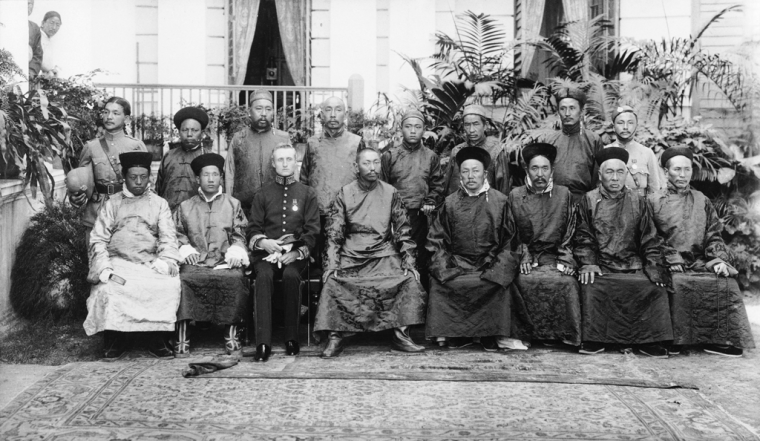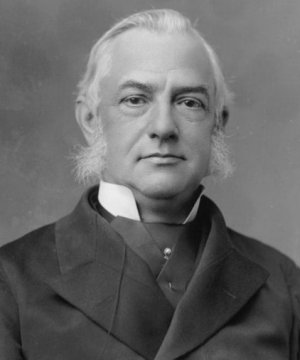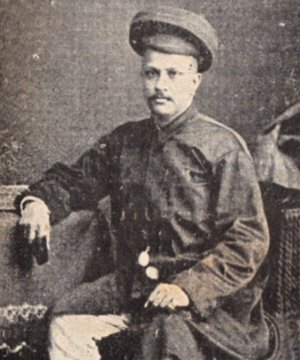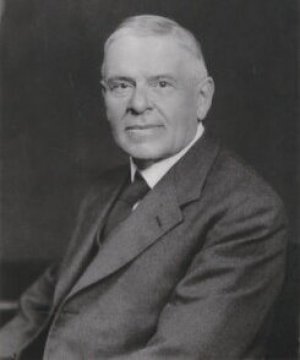| Library / Biographies |
Kazi Dawa Samdup Biography

Dawa Samdup (left) and Walter Evans-Wentz (photographed circa 1919).
Kazi Dawa Samdup was born on 17th 1868 June in Sikkim. His father, Shalngo Nimpenjo, was of the Guru Tashi clan, one of the four founding clans of Sikkim to which the Namgyal royal dynasty family of Sikkim belongs.
The honorific term “Kazi” indicates a superior social standing as a member of a landholding family of Tibetan origin settled in Sikkim.
On the death of his mother, his father remarried and had three more sons and two daughters from his second wife.
At the age of four Kazi Dawa Samdup started learning the Tibetan script from his grandfather.
In 1874 he was admitted as a boarder in the Bhutia Boarding School in Darjeeling—later Darjeeling Government High School. The headmaster Rai Bahadur Sarat Chandra Das was very pleased with the progress of his studies. His Tibetan languages teacher, Rai Bahadur Ugyen Gyatso, was a Tibeto-Sikkimese monk originally from the Pemayangtse monastery in West Sikkim.
After finishing school, he joined the service of British India as Chief Interpreter to the Commissioner of Raj Shahi Division and was posted to Buxaduar which was then part of Bhutan, from December 1887 until October 1893.

Sarat Chandra Das, the first director of Bhutia Boarding School in Darjeeling.When Kazi Dawa Samdup was working in Bhutan, he met his root teacher, Lopen Tshampa Norbu, in a hermitage near Buxaduar. Tshampa Norbu, also known as Hermit Guru Norbu (Tib. Slob-dpon-M tshams-pa-Nor-bu, Norbu meaning “Gem”), was a Bhutanese lāma of the Kagyu tradition ("Oral Lineage" or "Whispered Transmission" school).
Shortly after being accepted as a disciple (śiṣya), Kazi Dawa Samdup “received from him the teachings contained in The Epitome of the Great Symbol, with appropriate initiations and guiding instructions.”
Under the influence of his Guru, Kazi Dawa Samdup’s wanted to become an ordained monk. However, his father, then an old man, requested him to perform the usual duties of an eldest son and marry, to perpetuate the family. Following his father’s request, Kazi Dawa Samdup married and subsequently had two sons and one daughter.
When his father died, he became also responsible for looking after his stepmother, three younger brothers and two younger sisters.
He confessed to Alexandra David-Néel that although he admired the holy lamas, such a lifestyle was not for him. Kazi Dawa Samdup liked to drink fermented beverages and had difficulties in letting go of this habit, as the alcohol made him more temperamental.
In her book Magic and Mystery in Tibet, Alexandra David-Néel mentioned that she tried to persuade Kazi Dawa Samdup to totally abstain from drinking, like all Buddhists are required to. But he didn’t have the energy and it was impossible for him to resist his surroundings.
His Guru, Tshampa Norbu had three copies of The Epitome of the Great Symbol. In 1893, when Kazi Dawa Samdup was about to leave Bhutan, Tshampa Norbu gave him one copy of the text.
Around 1905 the ninth Maharaja of Sikkim Sir Thutob Namgyal was looking for a suitable headmaster, who could teach both Tibetan and English, for the state Bhutia Boarding School for boys at Gangtok.
The Crown Prince Sidkeong Tulku proposed Kazi Dawa Samdup for the job and he was nominated in 1906. On this occasion the copy The Epitome of the Great Symbol was lost when Kazi Dawa Samdup was about to move to Gangtok to assume the post of headmaster.

Students at Bhutia Boarding school in Gangtok (Source: Magic and Mystery in Tibet by Alexandra David-Neel)
According to Alexandra David-Néel, Kazi Dawa Samdup had a specific way of running the boarding school. As he could not bear to spend time in the classroom, he used to assign his duties to a lower master. He was often absent for an entire month and the boys often wandered around to play in the woods and neglected their study.
However, discipline would be fully restored whenever Kazi Dawa Samdup returned. According to David-Néel, Dawa Samdup used to give physical punishments to his students who were not able to answer his questions correctly.
In her book Magic and Mystery in Tibet, David-Néel wrote that Kazi Dawa Samdup was very devoted to his teacher, Tshampa Norbu, and was interested in mysticism and supernormal powers: “Dawasandup was an occultist and even, in a certain way, a mystic. He sought for secret intercourse with the Ḍākinīs and the dreadful gods hoping to gain supernormal powers. Everything that concerned the mysterious world of beings generally invisible strongly attracted him, but the necessity of earning his living made it impossible for him to devote much time to his favorite study.”
He was an avid reader and known to fall into a long, ecstatic trance over a text that especially pleased him.
His proficiency in the English and Tibetan languages often led to his services being requested for important occasions. In 1905, Kazi Dawa Samdup accompanied the Maharaja of Sikkim to Calcutta on the occasion of the visit of the British Heir Apparent and his consort, the Prince and Princess of Wales.
In 1910 he acted as interpreter and translator for the British Political Officer Sir Charles Bell during HH the 13th Dalai Lama’s visit to India. In December 1911, Kazi Dawa Samdup accompanied the Maharaja of Sikkim to Delhi for the Durbar coronation of the British king and queen as emperors of India.

Tibetan Delegation at Hastings House, Calcutta, 16 March 1910. Photograph, Liverpool, National Museums, Charles Alfred Bell Collection. Laden La (far left, standing), Tashi Wangdi (second from left, standing), Charles Bell (third from left, seated to the right of Dalai Lama), Gungthang Shapé (seated, far right). The third person standing from the left on the back is likely Kazi Dawa Samdup.
In 1912, The Crown Prince of Sikkim, Sidkeong Tulku Namgyal, requested Kazi Dawa Samdup to accompany Alexandra David-Néel, to meet the 13th Dalai Lama in Kalimpong. In this case, Kazi Dawa Samdup acted in the capacity of an interpreter, guide, and David-Néel’s teacher of the Tibetan language.
In 1914, his services were utilized once again by the British Political Officer Sir Charles Bell during the historic Simla Convention on the Indo-Tibet Border signed between India, Tibet and China.
In February 1916, Kazi Dawa Samdup visited his teacher to request permission and assistance in translating the Demchog Tantra with Sir John Woodroffe. During this visit, Kazi Dawa Samdup also obtained permission to translate The Epitome of the Great Symbol and other similar yogic treatises.
Tshampa Norbu told Kazi Dawa Samdup that very few of their own people would care to strive earnestly for spiritual development, and there would be more appeal to truth-seekers in Europe and in America. Knowing that Kazi Dawa Samdup had lost his copy of The Epitome of the Great Symbol, Tshampa Norbu gave him another copy before their parting. Unfortunately, this copy was also lost.
Several months after their last meeting took place, Tshampa Norbu passed away in October 1916 at the age of 78.
In 1919, Kazi Dawa Samdup edited the English translation and the Tibetan text of the Śrī Cakrasaṃvara Tantra: A Buddhist Tantra (Dem-chog Tantra) 1, which was published by Sir John Woodroffe as Volume 7 of the Tantrik Texts.
In 1919 Walter Yeeling Evans-Wentz, an American orientalist, was looking for a translator from Tibetan and Sardar Bahadur Laden La, a police officer he met in Darjeeling, provided him with a letter of recommendation to Kazi Dawa Samdup. Together they worked on translating and editing four texts: The Tibetan Book of the Dead (Bardo Thödol) 2, Tibet’s Great Yogi Milarepa3, The Tibetan Book of the Great Liberation4 and Tibetan Yoga and Secret Doctrines5.
As the second copy of The Epitome of the Great Symbol, to be included in the Tibetan Yoga and Secret Doctrines volume was lost, Kazi Dawa Samdup borrowed the copy from Tshampa Norbu’s other student in Buxaduar to translate the text.
In 1919 Sir Asutosh Mukerjee, the then Vice Chancellor, appointed Kazi Dawa Samdup as Professor of Tibetan at Calcutta University where he compiled and published his English-Tibetan dictionary. The dictionary was and remains unique because it also contains meanings in the Sikkimese and Dzongkha languages.
Kazi Dawa Samdup, unfortunately didn’t live to see all his translations published. Being a man from the hills, he could not adjust to the hot and humid climate of Calcutta. His health rapidly deteriorated and he died on 22nd March 1922 at Calcutta General Hospital.
Kazi Dawa Samdup’s friend Profulla Shankar Sen wrote in his obituary, “Kazi Dawa Samdup was an early riser, at 4 am he used to be out of bed. After his morning ritual of prayers, he would set about his day’s task. A hard worker who worked himself to early death in the hot climate of Calcutta. He was simple in his bearing, enjoyed long discourse with learned people.”

Sarki Tshering, Kazi Dawa Samdup's half brother, a famous Theravada buddhist.
Among Kazi Dawa Samdup’s siblings, the youngest half-brother Sarki Tshering—also known as Pemba Thendup according to some sources—acquired equal fame and honor in Sri Lanka as Reverend S. Mahinda Thero. In recognition of his contribution towards the propagation of Buddhism, and the development of Pali and Sinhala languages, the Sri Lankan government erected a statue in his name and issued commemorative postage stamps in his memory.
Pemba Thendup was mainly recognized as a poet monk, whose poems and songs inspired the Sri Lankan people during their independence movement. Considered as a national hero, his patriotic and devotional songs are used in school textbooks to instill a national feeling.
The older half-brother, Phurba Dhondup, also went to Sri Lanka to study Theravada Buddhism, while the youngest half-brother, Bhyapo, joined the British Army and died in action during World War I.
Footnotes
1. Śrī Cakrasaṃvara Tantra: A Buddhist Tantra, Edited Kazi Dawa-Samdup. Edited by John Woodroffe. Translated by Kazi Dawa-Samdup. Tantrik Texts V. 7. London: Luzac & Co., 1919.
2. The Tibetan book of the dead; or, The after-death experiences on the Bardo plane, according to Lāma Kazi Dawa-Samdup’s English rendering, with foreword by Sir John Woodroffe, London, Oxford University Press, H. Milford, 1927.
3. Evans-Wentz, W. Y.,ed. Tibet’s Great Yogi, Milarepa: A Biography from the Tibetan; Being the Jetsün-Kahbum or Biographical History of Jetsün-Milarepa According to the Late Lama Kazi Dawa-Samdup's English Rendering. London: Oxford University Press, 1928.
4. The Tibetan book of the great liberation; or, the method of realizing nirvana through knowing the mind, preceded by an epitome of Padma-Sambhava’s biography and followed by Guru Phadampa Sangay’s teachings. According to English renderings by Sardar Bahädur S. W. Laden La and by the Lāmas Karma Sumdhon Paul, Lobzang Mingyur Dorje, and Kazi Dawa-Samdup. Introductions, annotations, and editing by W. Y. Evans-Wentz. With psychological commentary by C.G. Jung. London, New York, Oxford University Press, 1954.
5. Evans-Wentz, W. Y., ed. Tibetan Yoga and Secret Doctrines, or, Seven Books of Wisdom of the Great Path, According to the Late Lama Kazi Dawa-Samdup’s English Rendering. London: Oxford University Press, 1935.





